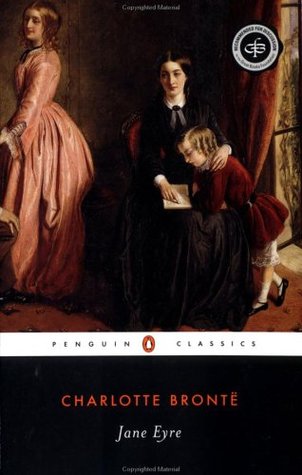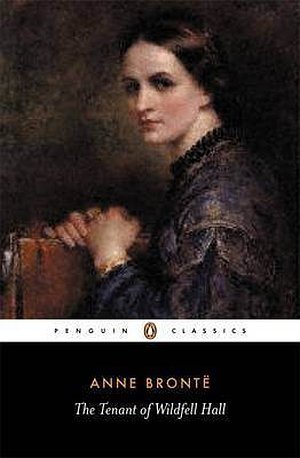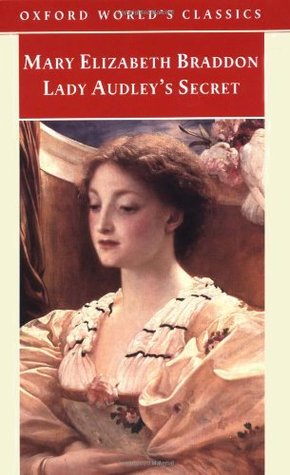Popular Gothic Revival Books
15+ [Hand Picked] Popular Books On Gothic Revival
Discover the list of some best books written on Gothic Revival by popular award winning authors. These book on topic Gothic Revival highly popular among the readers worldwide.

Jane Eyre by Charlotte Brontë , Michael Mason (Editor)
Orphaned as a child, Jane has felt an outcast her whole young life. Her courage is tested once again when she arrives at Thornfield Hall, where she has been hired by the brooding, proud Edward Rochester to care for his ward Adèle. Jane finds herself drawn to his troubled yet kind spirit. She falls in love. Hard. But there is a terrifying secret inside the gloomy, forbiddin Orphaned as a child, Jane has felt an outcast her whole young life. Her courage is tested once again when she arrives at Thornfield Hall, where she has been hired by the brooding, proud Edward Rochester to care for his ward Adèle. Jane finds herself drawn to his troubled yet kind spirit. She falls in love. Hard. But there is a terrifying secret inside the gloomy, forbidding Thornfield Hall. Is Rochester hiding from Jane? Will Jane be left heartbroken and exiled once again?
I WANT TO READ THIS
Frankenstein by Mary Wollstonecraft Shelley , Charlotte Gordon (Introduction)
Mary Shelley began writing Frankenstein when she was only eighteen. At once a Gothic thriller, a passionate romance, and a cautionary tale about the dangers of science, Frankenstein tells the story of committed science student Victor Frankenstein. Obsessed with discovering the cause of generation and life and bestowing animation upon lifeless matter, Frankenstein assembles Mary Shelley began writing Frankenstein when she was only eighteen. At once a Gothic thriller, a passionate romance, and a cautionary tale about the dangers of science, Frankenstein tells the story of committed science student Victor Frankenstein. Obsessed with discovering the cause of generation and life and bestowing animation upon lifeless matter, Frankenstein assembles a human being from stolen body parts but; upon bringing it to life, he recoils in horror at the creature's hideousness. Tormented by isolation and loneliness, the once-innocent creature turns to evil and unleashes a campaign of murderous revenge against his creator, Frankenstein. Frankenstein, an instant bestseller and an important ancestor of both the horror and science fiction genres, not only tells a terrifying story, but also raises profound, disturbing questions about the very nature of life and the place of humankind within the cosmos: What does it mean to be human? What responsibilities do we have to each other? How far can we go in tampering with Nature? In our age, filled with news of organ donation genetic engineering, and bio-terrorism, these questions are more relevant than ever.
I WANT TO READ THIS
The Picture of Dorian Gray by Oscar Wilde , Jeffrey Eugenides (Introduction)
Written in his distinctively dazzling manner, Oscar Wilde’s story of a fashionable young man who sells his soul for eternal youth and beauty is the author’s most popular work. The tale of Dorian Gray’s moral disintegration caused a scandal when it first appeared in 1890, but though Wilde was attacked for the novel’s corrupting influence, he responded that there is, in fact, Written in his distinctively dazzling manner, Oscar Wilde’s story of a fashionable young man who sells his soul for eternal youth and beauty is the author’s most popular work. The tale of Dorian Gray’s moral disintegration caused a scandal when it first appeared in 1890, but though Wilde was attacked for the novel’s corrupting influence, he responded that there is, in fact, “a terrible moral in Dorian Gray.” Just a few years later, the book and the aesthetic/moral dilemma it presented became issues in the trials occasioned by Wilde’s homosexual liaisons, which resulted in his imprisonment. Of Dorian Gray’s relationship to autobiography, Wilde noted in a letter, “Basil Hallward is what I think I am: Lord Henry what the world thinks me: Dorian what I would like to be—in other ages, perhaps.”
I WANT TO READ THIS
Dracula by Bram Stoker , Nina Auerbach (Editor) , Kara Shallenberg (Narrator) , David J. Skal (Editor)
You can find an alternative cover edition for this ISBN here and here. A rich selection of background and source materials is provided in three areas: Contexts includes probable inspirations for Dracula in the earlier works of James Malcolm Rymer and Emily Gerard. Also included are a discussion of Stoker's working notes for the novel and "Dracula's Guest," the original open You can find an alternative cover edition for this ISBN here and here. A rich selection of background and source materials is provided in three areas: Contexts includes probable inspirations for Dracula in the earlier works of James Malcolm Rymer and Emily Gerard. Also included are a discussion of Stoker's working notes for the novel and "Dracula's Guest," the original opening chapter to Dracula. Reviews and Reactions reprints five early reviews of the novel. "Dramatic and Film Variations" focuses on theater and film adaptations of Dracula, two indications of the novel's unwavering appeal. David J. Skal, Gregory A. Waller, and Nina Auerbach offer their varied perspectives. Checklists of both dramatic and film adaptations are included. Criticism collects seven theoretical interpretations of Dracula by Phyllis A. Roth, Carol A. Senf, Franco Moretti, Christopher Craft, Bram Dijkstra, Stephen D. Arata, and Talia Schaffer. A Chronology and a Selected Bibliography are included.
I WANT TO READ THIS
Wuthering Heights by Emily Brontë , Richard J. Dunn (Editor) , David Timson (Narrator) , Charlotte Brontë (Commentary) , Ruth Golding (Narrator) , Robert Heindel (Illustrator)
You can find the redesigned cover of this edition HERE. This best-selling Norton Critical Edition is based on the 1847 first edition of the novel. For the Fourth Edition, the editor has collated the 1847 text with several modern editions and has corrected a number of variants, including accidentals. The text is accompanied by entirely new explanatory annotations. New to the You can find the redesigned cover of this edition HERE. This best-selling Norton Critical Edition is based on the 1847 first edition of the novel. For the Fourth Edition, the editor has collated the 1847 text with several modern editions and has corrected a number of variants, including accidentals. The text is accompanied by entirely new explanatory annotations. New to the fourth Edition are twelve of Emily Bronte's letters regarding the publication of the 1847 edition of Wuthering Heights as well as the evolution of the 1850 edition, prose and poetry selections by the author, four reviews of the novel, and poetry selections by the author, four reviews of the novel, and Edward Chitham's insightful and informative chronology of the creative process behind the beloved work. Five major critical interpretations of Wuthering Heights are included, three of them new to the Fourth Edition. A Stuart Daley considers the importance of chronology in the novel. J. Hillis Miller examines Wuthering Heights's problems of genre and critical reputation. Sandra M. Gilbert assesses the role of Victorian Christianity plays in the novel, while Martha Nussbaum traces the novel's romanticism. Finally, Lin Haire-Sargeant scrutinizes the role of Heathcliff in film adaptations of Wuthering Heights. A Chronology and updated Selected Bibliography are also included.
I WANT TO READ THIS
Skull Flowers by Jazon Dion Fletcher
Step into a story where forgotten legends, ancient sorceries, and high-technologies come together to create a world of scientific wonder and barbaric magic, where the stars will shine forever, where the sky it never ends, where all shall ride eternal, and the moonlight will attend, amongst, the riots, and make-believe...
I WANT TO READ THIS
The Woman in White by Wilkie Collins , Matthew Sweet (Annotations)
'In one moment, every drop of blood in my body was brought to a stop... There, as if it had that moment sprung out of the earth, stood the figure of a solitary Woman, dressed from head to foot in white' The Woman in White famously opens with Walter Hartright's eerie encounter on a moonlit London road. Engaged as a drawing master to the beautiful Laura Fairlie, Walter become 'In one moment, every drop of blood in my body was brought to a stop... There, as if it had that moment sprung out of the earth, stood the figure of a solitary Woman, dressed from head to foot in white' The Woman in White famously opens with Walter Hartright's eerie encounter on a moonlit London road. Engaged as a drawing master to the beautiful Laura Fairlie, Walter becomes embroiled in the sinister intrigues of Sir Percival Glyde and his 'charming' friend Count Fosco, who has a taste for white mice, vanilla bonbons, and poison. Pursuing questions of identity and insanity along the paths and corridors of English country houses and the madhouse, The Woman in White is the first and most influential of the Victorian genre that combined Gothic horror with psychological realism. Matthew Sweet's introduction explores the phenomenon of Victorian 'sensation' fiction, and discusses Wilkie Collins's biographical and societal influences. Included in this edition are appendices on theatrical adaptations of the novel and its serialisation history.
I WANT TO READ THIS
The Strange Case of Dr. Jekyll and Mr. Hyde by Robert Louis Stevenson , Vladimir Nabokov (Introduction) , Mervyn Peake (Illustrator) , Dan Chaon (Afterword)
Strange Case of Dr Jekyll and Mr Hyde is the original title of a novella written by the famous Scottish author Robert Louis Stevenson that was first published in 1886. The work is commonly known today as The Strange Case of Dr Jekyll and Mr Hyde, Dr Jekyll and Mr Hyde, or simply Jekyll & Hyde. It is about a London lawyer named John Gabriel Utterson who investigates str Strange Case of Dr Jekyll and Mr Hyde is the original title of a novella written by the famous Scottish author Robert Louis Stevenson that was first published in 1886. The work is commonly known today as The Strange Case of Dr Jekyll and Mr Hyde, Dr Jekyll and Mr Hyde, or simply Jekyll & Hyde. It is about a London lawyer named John Gabriel Utterson who investigates strange occurrences between his old friend, Dr Henry Jekyll, and the evil Edward Hyde.
I WANT TO READ THIS
Northanger Abbey by Jane Austen , Alfred MacAdam (Introduction)
Jane Austen's first novel—published posthumously in 1818—tells the story of Catherine Morland and her dangerously sweet nature, innocence, and sometime self-delusion. Though Austen's fallible heroine is repeatedly drawn into scrapes while vacationing at Bath and during her subsequent visit to Northanger Abbey, Catherine eventually triumphs, blossoming into a discerning wom Jane Austen's first novel—published posthumously in 1818—tells the story of Catherine Morland and her dangerously sweet nature, innocence, and sometime self-delusion. Though Austen's fallible heroine is repeatedly drawn into scrapes while vacationing at Bath and during her subsequent visit to Northanger Abbey, Catherine eventually triumphs, blossoming into a discerning woman who learns truths about love, life, and the heady power of literature. The satirical novel pokes fun at the gothic novel while earnestly emphasizing caution to the female sex.
I WANT TO READ THIS
Uncle Silas by J. Sheridan Le Fanu , Victor Sage (Introduction)
One of the most significant and intriguing Gothic novels of the Victorian period and is enjoyed today as a modern psychological thriller. In UNCLE SILAS (1864) Le Fanu brought up to date Mrs Radcliffe's earlier tales of virtue imprisoned and menaced by unscrupulous schemers. The narrator, Maud Ruthyn, is a 17 year old orphan left in the care of her fearful uncle, Silas. To One of the most significant and intriguing Gothic novels of the Victorian period and is enjoyed today as a modern psychological thriller. In UNCLE SILAS (1864) Le Fanu brought up to date Mrs Radcliffe's earlier tales of virtue imprisoned and menaced by unscrupulous schemers. The narrator, Maud Ruthyn, is a 17 year old orphan left in the care of her fearful uncle, Silas. Together with his boorish son and a sinister French governess, Silas plots to kill Maud and claim her fortune. The novel established Le Fanu as a master of horror fiction.
I WANT TO READ THIS
The Mysteries of Udolpho by Ann Radcliffe
With The Mysteries of Udolpho, Ann Radcliffe raised the Gothic romance to a new level and inspired a long line of imitators. Portraying her heroine's inner life, creating a thick atmosphere of fear, and providing a gripping plot that continues to thrill readers today, The Mysteries of Udolpho is the story of orphan Emily St. Aubert, who finds herself separated from the man With The Mysteries of Udolpho, Ann Radcliffe raised the Gothic romance to a new level and inspired a long line of imitators. Portraying her heroine's inner life, creating a thick atmosphere of fear, and providing a gripping plot that continues to thrill readers today, The Mysteries of Udolpho is the story of orphan Emily St. Aubert, who finds herself separated from the man she loves and confined within the medieval castle of her aunt's new husband, Montoni. Inside the castle, she must cope with an unwanted suitor, Montoni's threats, and the wild imaginings and terrors that threaten to overwhelm her. This new edition includes an introduction that discusses the publication and early reception of the novel, the genre of Gothic romance, and Radcliffe's use of history, exotic settings, the supernatural, and poetry.
I WANT TO READ THIS
The Tenant of Wildfell Hall by Anne Brontë , Stevie Davies (Editor, Introduction)
Note: Editions of The Tenant that start with: "You must go back with me..." are incomplete. Actual opening line of the novel is: "To J. Halford, Esq. Dear Halford, when we were together last..." This is the story of a woman's struggle for independence. Helen "Graham" has returned to Wildfell Hall in flight from a disastrous marriage. Exiled to the desolate moorland mansion, Note: Editions of The Tenant that start with: "You must go back with me..." are incomplete. Actual opening line of the novel is: "To J. Halford, Esq. Dear Halford, when we were together last..." This is the story of a woman's struggle for independence. Helen "Graham" has returned to Wildfell Hall in flight from a disastrous marriage. Exiled to the desolate moorland mansion, she adopts an assumed name and earns her living as a painter.
I WANT TO READ THIS
Lady Audley's Secret by Mary Elizabeth Braddon
This Victorian bestseller, along with Braddon's other famous novel, Aurora Floyd, established her as the main rival of the master of the sensational novel, Wilkie Collins. A protest against the passive, insipid 19th-century heroine, Lady Audley was described by one critic of the time as "high-strung, full of passion, purpose, and movement." Her crime (the secret of the tit This Victorian bestseller, along with Braddon's other famous novel, Aurora Floyd, established her as the main rival of the master of the sensational novel, Wilkie Collins. A protest against the passive, insipid 19th-century heroine, Lady Audley was described by one critic of the time as "high-strung, full of passion, purpose, and movement." Her crime (the secret of the title) is shown to threaten the apparently respectable middle-class world of Victorian England.
I WANT TO READ THIS
The Monk by Matthew Lewis
Set in the sinister monastery of the Capuchins in Madrid, this is a violent tale of ambition, murder, and incest. The struggle between maintaining monastic vows and fulfilling personal ambitions tempts its main character into breaking his vows.
I WANT TO READ THIS
Armadale by Wilkie Collins , John Sutherland (Editor)
The novel has a convoluted plot about two distant cousins both named Allan Armadale. The father of one had murdered the father of the other (the two fathers are also named Allan Armadale). The story starts with a deathbed confession by the murderer in the form of a letter to be given to his baby son when he grows up. Many years are skipped over. The son, mistreated at home The novel has a convoluted plot about two distant cousins both named Allan Armadale. The father of one had murdered the father of the other (the two fathers are also named Allan Armadale). The story starts with a deathbed confession by the murderer in the form of a letter to be given to his baby son when he grows up. Many years are skipped over. The son, mistreated at home, runs away from his mother and stepfather, and takes up a wandering life under the assumed name of Ozias Midwinter.
I WANT TO READ THIS